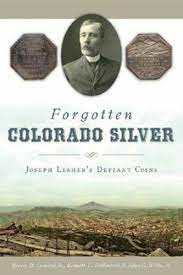Post by Doris McCraw aka Angela Raines
 |
| Victor Colorado photo (c) and property of the Author |
Some may have heard of Joseph Lesher, especially if you are into numismatics. Many may have not.
Lesher was born in Ohio in July of 1838 according to records. When the Civil War broke out he joined the Union Army.
After the war, like many others, Lesher headed West. He mined in various areas of Colorado, including Georgetown, and Leadville along with sites in the San Juan mountains. He may have owned a silver mine near Central City but would have lost much of his wealth during the 1873 demonetization of silver.
When gold was found in the Cripple Creek/Victor area Lesher headed up that way and settled in Victor. Some stories say he found work, first as a miner, then eventually as a shift boss, and later getting involved in politics. Other stories have him amassing his wealth by investing in real estate.
Regardless, Lesher believed in silver and in 1900 he launched the production of his own silver coinage. He called his dollar-sized coins of varying value the 'referendum souvenir' medals. They were eight-sided to help distinguish them from the U. S. currency. He had minted about 100 of these coins when the federal government said they were counterfeit and confiscated his dies. This is despite the businesses that accepted them as money.
Lesher then consulted the U.S. Attorney's office to make sure his new coinage would not add further legal trouble. This time he stamped the name of a grocer in Victor who agreed to accept them for merchandise.
For the remainder of 1900 and part of 1901, Lesher produced five types of 'dollars' using the names of various businesses not only in Cripple Creek and Victor bug Colorado Springs, Pueblo, Salida, Denver, and Grand Junction.
In 1901 Lesher discontinued his production, but now over a century later his coins are worth more to coin collectors than you would believe as only around 1,800 of the coins have been found.
Joseph Lesher died around 1918 in his home in Victor, Colorado but what an unusual legacy he left. For those who would like to know more you may like the following book: "Forgotten Colorado Silver: Joseph Lesher's Defiant Coins" by Robert D. Leonard Jr., Ken Hallenbeck, Adna G. Wilde Jr.
Until Next Time: Stay safe, Stay happy, and Stay healthy.
Doris








